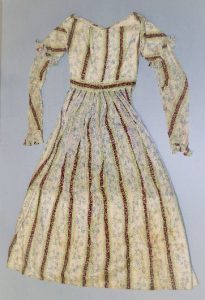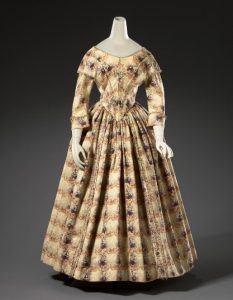

Sophia Bates Truscott was born on January 18, 1830 in Kingston, Ontario to William and Sarah Bates. She got married to George Truscott, a businessman, in 1852 after they met in Port Hope, Ontario. Together they had 4 children, Rosa, Ida, Lillian, and George. She died on Mackinac Island in 1911. Little is known about her upbringing except for the fact that her dress is in our collection and that she made it herself.
As a young woman she had fine sewing skills with an attention for detail. This is not surprising as many young girls were taught how to sew, cook, and clean, so that one day they could be housewives for their husbands. Sophia sewed the dress at age 14. At that age, she would most likely worn the same garments as her mother since most Victorian children dressed as miniature adults. The dress matched similar designs of the 1840’s women’s fashion. A typical 1840’s day dress ensemble would be as follows: Cotton chemise, corset, drawers, a crinoline (or a hoop skirt), multiple petticoats and a day dress that would go over. Often the lady would wear a hat and have a parasol if she was going out.


Comparing it to the example from England, Sophia’s dress is a good example of a typical 1840’s day dress. There were many variations of the neckline as some women had a V-neck bodice or the fabric covered up to the neck. Her dress has a low sloped neckline and long sleeves that puff at the shoulders, which was common. The pointed bodice of the women’s day dress is different than Sophia’s dress as it is hemmed across the waist. It is possible that she did not wear a corset because corsets of the time were pointed down in the front and the bodice matched. Unfortunately, there is not enough information to really know for sure the type of undergarments she wore. It is a fine garment and can help researchers understand children’s clothing of the early Victorian era. The dress was donated to us by descendant Marcia Dort Hinkley. It has been preserved through four generations of women.








